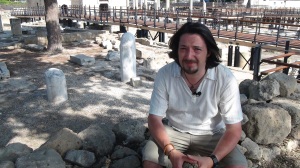In 1965 the Polish Archaeological Mission from the university of Warsaw excavated at Pahpos and found an excellent amount of remains from ancient Paphos (A guide to Biblical sites in Greece and Turkey. Fant/Reddish. Page 354. Oxford University press. Note: This book actually claims the date of 1966, but Cyprus officials claim the date to be 1965).
The recently excavated area known as the Archaeological site at Paphos, is near the harbour. It contains many distinct links to the Biblical Narrative of Acts 13: and primarily the spot which, I think, was the actual site where Paul stood before the one Sergius Paulus, the proconsul and Roman official. Cyprus had been made a Roman province in 58 BC and in 27 BC it became a Senatorial province and by the time Paul, Barnabus and Mark visited the island, it was governed by the Proconsul (Acts 13: 7)
Until 1966 archaeologists and historians claimed their was no evidence for Sergius Paulus, or a proconsul at Cyprus but when the seat of the Proconsul was found during excavations, it proved that Luke was right after all. The Bible has a habit of vindicating itself against historical objections made by archaeologists and historians. Such was the case with this find in 1965. Today however, there remains little or no mention of the connection between what is called “The house of Theseus” and Acts 13. In fact, an authority at this site during my first visit to Paphos made it clear to me the site had absolutely nothing whatsoever to do with St Paul or the New Testament? I respectfully disagreed.
The fact remains that the area what could be known as the governors palace is said to date back to the 2nd century AD and some towards the 4-5th centuries AD, in their present revealed form. However, if foundational remains do in fact date to the 2nd century AD, this does not exclude this site as being the actual place or area of Paul’s encounter with Sergius Paulus, in fact, we could conclude that if the site is 2nd century AD as suggested, then it is more than possible that the Roman official built this villa upon earlier houses of the Hellenistic and Roman periods. However. The evidence only suggests a date of mid 2nd century AD, but such conclusions are only drawn from what we know at present and are not absolute. However, more evidence may appear at a later date which if so, should offer us more insight into an absolute accurate date? However, I am certain that the evidence more than suggests that this was the spot, if not the actual villa at which the events of Acts 13: took place. It is probable that Paul stood before Sergius Paulus in the area which is known as the Double room or at least in a hall such as this.
The distinct importance of this area historically, is that it does not even remotely contradict the Biblical Narrative and it is likely that after this event at this spot, that Paul, the Saul referred to himself by his Roman name of ‘Paul’. I say this because prior to Acts 13: 9 Paul is referred to as “Saul” whereas from the moment the Roman Proconsul, who’s name is remarkably similar, “Sergius Paulus” was converted, Paul is referred to by Luke as “Paul”. This means that Paul connected his Roman name to that of ‘Sergius Paulus’ and it was from the port at Paphos where Paul is first referred to as “Paul” (Acts 13: 13)
This event is one of the most significant events of Cypriot history and this is due to the conversion of the Roman Official and King Official Sergius Paulus. This was Christianity’s first penetration into the Roman Empire and no doubt led to a significant amount of Roman persecution upon Christians by Roman Emperors in the years to come.
© 2012 Simon Peter Sutherland



